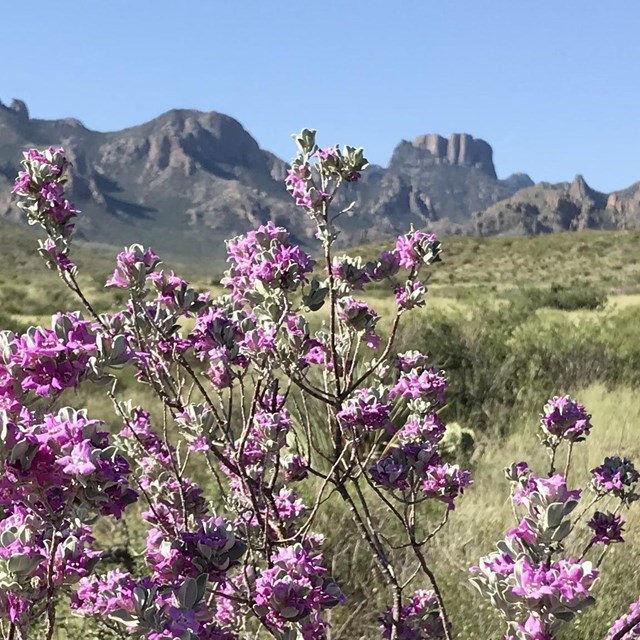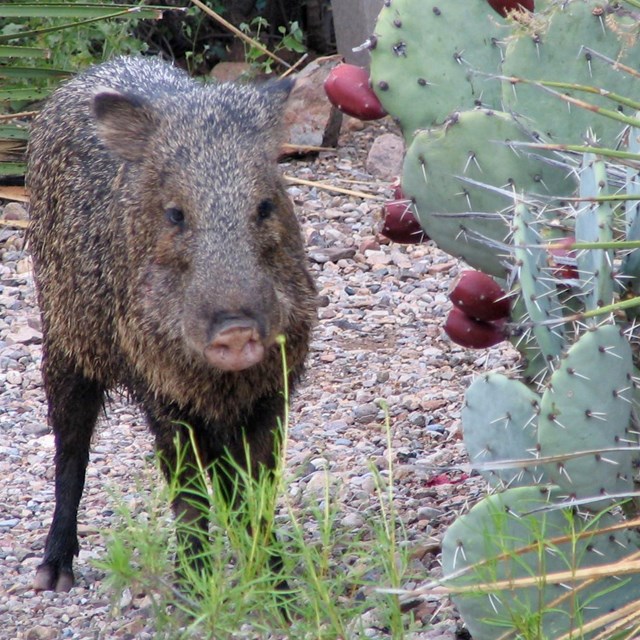
NPS Photo/Blake Trester
A Big Bend Overview The author Fredrick Gelbach describes these borderlands aptly when he calls them “a carpet of interacting plants and animals deftly woven on a geologic loom.” This statement conjures up images of looming mountains, stark desert landscapes, and a ribbon of water slicing through it all. And, indeed, this is what Big Bend and the surrounding area is—a diverse natural area of river, desert, and mountains, and a land of extremes—hot and cold, wet and dry, high and low. To wander the shimmering desert flats, to ascend the rimrocks of the desert mountains, to float the canyons of the Rio Grande—to be “on the border"— is to experience sights and sounds and solitude unmatched elsewhere. 
NPS Photo/Eric Leonard In the heart of Big Bend National Park lie the Chisos Mountains, mountains born of fire during volcanic eruptions and intrusions 40 - 60 million years ago and exposed by the incessant forces of erosion. As you ascend the slopes of the Chisos, the thorns of the desert give way to evergreens like pinyon pine and juniper, and oak trees appear. Some surprising species living at the very limit of their ranges can be found in the higher, moister areas—bigtooth maple, quaking aspen, and Douglas fir. Although only 2% of the park is woodland, this area draws people like a magnet—especially in the summer—as daytime temperatures are usually about 20 degrees cooler than by the river. Here, in this mountain island surrounded by a desert sea, one can find flora and fauna unique to the Chihuahuan desert and some unique to Big Bend. Whether hiking to gain a glimpse of the colima warbler, a much sought after bird by birdwatchers which winters in Mexico but is only seen in Big Bend here in the U.S., or to get a coveted look at a mountain lion or black bear, or to see the towering displays of the century plants in bloom—whatever the reason, visitors to the Chisos are struck by the contrasts the mountains provide—prickly pear and pine tree side by side, snow-covered cactus, and a waterfall flowing through a feature called the “Window” to the desert below. It’s been said that if the Chisos Mountains are the heart of Big Bend, then the desert floor is its soul. Ninety-eight percent of the park is desert, and like the mountains, the desert is a land of contrasts—a place where you can touch 400 million year old rocks with one hand, and a day-old flower with the other, where extremes of temperatures of 50 degrees or more between dawn and mid-day are not uncommon. 
NPS Photo/Eric Leonard Big Bend’s desert landscape itself is a study in contrasts—mesas, mountains, and dikes formed by volcanic activity, limestone ridges and cliffs formed 100 - 200 million years ago when shallow seas covered the area, and ever-changing arroyos, dry most of the year, but subject to violent flash flooding during summer rains. Water is truly the “architect” of the desert, as its presence or absence determines the way the desert looks, its plant and animal life, and the way humans have been able to use it through time. Lest you feel a pang of pity for the roadrunners, coyotes, or javelinas you may encounter living in this harsh land, don’t—the adaptations that allow these creatures to live here are no less than amazing, and, in fact, even allow them to thrive. Instead, think of the land not as burdened by its lack (or in some months, abundance) of water, but rather as blessed. It is this cycle of wet and dry, so unfamiliar to those from wetter climates, that allows us our spectacular display of bluebonnets, yucca blossoms, and other spectacular wildflowers. Our water, although paltry to some, is enough—for a desert. Any more, and this place would be something very different. 
NPS Photo/Tom VandenBerg The one location where you can count on seeing water in Big Bend is along the Rio Grande—an oasis that’s been called the “lifeblood” of Big Bend. To drift through the majestic canyons of the Rio Grande with your oars touching two countries at the same time is to span time and space. Although the river, as the boundary between the United States and Mexico, looks like a solid line on the maps of the area, it is always changing, always going somewhere, and it takes us along on its current opening our eyes to a panorama of towering cliffs, brilliant bird life, and grassy vegas or beaches. As you drift with the current, you may see both the expected and the unexpected—the black phoebe flitting to and fro, a turtle - a Big Bend slider, perhaps—perched on a rock slipping with a quiet “plop” into the water, swallows darting into their mud-nest “apartments”, or a peregrine falcon stooping to its prey. And then, at night, the display of stars, connecting you to other parts of the world as well as to other worlds. A visit to Big Bend provides opportunities for us to escape to isolation seldom found in daily life—a chance to experience unfamiliar creatures and plants, an endless expanse of stark desert and mountain scenery, and the vast space, heat, and silence that is the essence of the desert. Big Bend has been described as harsh, isolated, lonely, parched, and desolate, but for some people, in all of these adjectives—in the remoteness and isolation—lies the fascination of the Chihuahuan desert. From the earliest days of human occupation, people have recognized the value of this rugged land that the Spanish called “El Despoblado,” and as a result, the people and the land have had a long partnership here.
|
Last updated: January 22, 2025



